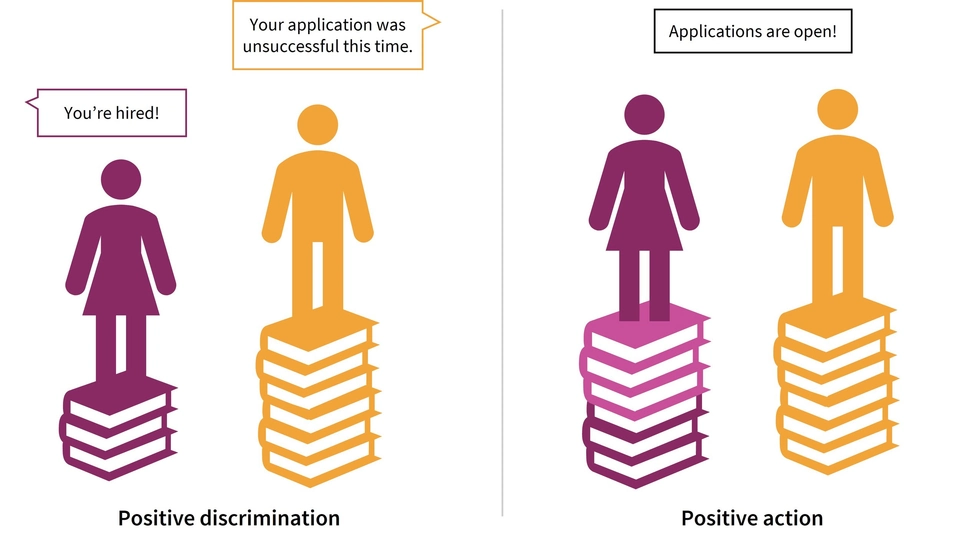- Introdcution
- But first, what is a protected characteristic?
- The distinction between positive discrimination and action
- Positive discrimination in more detail
- Are there any exceptions to the rule?
- Positive action in more detail
- More resources:
Positive discrimination or positive action?
Introdcution
With the prevalence of cognitive biases, there is no level playing field for candidates when applying for roles, meaning often individuals possessing particular protected characteristics may be treated less favourably. As organisation’s are recognizing and addressing this problem, there appears to be a real confusion around the concept of positive discrimination and what is it. Positive discrimination is actually illegal in the UK and US, and often when people use this term, they’re mistaken for positive action. This blog aims to clear up any confusion, exploring the distinction between positive discrimination and action, considering examples, and the outcomes of both.
But first, what is a protected characteristic?
Under the Equality Act 2010 in the UK, there are 9 protected characteristics: age, disability, gender reassignment, marriage and civil partnership, pregnancy and maternity, race, religion or belief, sex, and sexual orientation [1].
The distinction between positive discrimination and action
Positive discrimination refers to the automatic favouring of somebody who belongs to a minority protected characteristic group without proper consideration of merit and this is illegal in the UK under the Equality Act 2010 [2;3]. Positive discrimination would include promoting a woman over a man, despite him being more qualified for the role.
In contrast, positive action refers to the steps an employer can take to aid a certain group of people who are potentially disadvantaged in the hiring process [4]. This could take the form of offering the women, transgender, and nonbinary individuals in a company a training program to help them progress to a senior role while keeping applications open to everyone.
So in short, positive discrimination still discriminates against a group of individuals, whereas positive action provides assistance so that equal opportunities are provided without any group being favored.

Positive discrimination in more detail
Positive discrimination is the preferential treatment towards an individual or group of people who would usually be disadvantaged in the hiring process. However, treating someone preferentially because of a protected characteristic is discrimination, regardless of whether it’s positive or negative, and for that reason, it is currently illegal in the UK, despite there being a debate about whether this should be the case. Some examples of what this could look like include:
-
Promoting a male employee because all other managers of female, despite there being a more qualified female applicant for the role.
-
Deciding to hire a transgender applicant over a cisgender applicant, despite them having a weaker application and interview.
Positive discrimination can help drive diversity into an organization, providing opportunities to individuals that they would not otherwise get which could then interrupt a negative hiring cycle (i.e. by narrowing the skills gap and diversifying the interview panel). However, positive discrimination can be quite problematic as it can seem condescending, and it can result in “token” individuals being appointed roles, in addition to undermining the achievements of members of minority groups.
Are there any exceptions to the rule?
In very few circumstances, exceptions can be made, and positive discrimination can be allowed:
-
In care roles: To avoid causing distress to residents, it would be acceptable for a women’s refuge to require all members of staff to be women.
-
In the final decision between two identical candidates: you cannot treat a candidate with a protected characteristic preferentially, unless when there is the final decision to be made between two otherwise identical applicants. However, this is very unlikely as it is rare two candidates are matched in terms of education, experience, skills, and interview performance.
Positive action in more detail
Like positive discrimination, positive action addresses inequalities, but unlike positive discrimination, it does not disadvantage another group, rather, it provides opportunities that help even the application playing field. Examples include:
-
Ensuring language in the job description and throughout the hiring process is as inclusive as it can be.
-
Advertising roles to roles that target different groups of people i.e. those with disabilities.
-
Offering training to different groups of people.
-
In the job description, promoting family-friendly policies.
-
Holding/attending events that target minority groups.
Positive action is great because it helps disadvantaged individuals, without disadvantaging anyone else, widening the talent pool and increasing the diversity of organisations. In doing so, this can act as a catalyst for narrowing the skill shortage gap, and further attracting a more diverse range of applicants to the role, which in the long term will result in more promotions for these groups.
More resources:
-
Information on protected characteristics: Protected characteristics | Equality and Human Rights Commission (equalityhumanrights.com)
-
What is positive discrimination? What is Positive Discrimination in the UK? | Croner
-
What is positive action? Positive Action | Equality & Diversity (cam.ac.uk)
-
How to do ‘positive action’? Employers: quick start guide to positive action in recruitment and promotion - GOV.UK (www.gov.uk)
** Author:** Emma Bluck (Marketing and Scientific Communications Lead)
Start Building a Fairer Workplace With Us
Dive into the future of work with our expertly crafted solutions. Experience firsthand how MeVitae’s AI-driven solutions can make a difference. Request a demo or consultation now.
